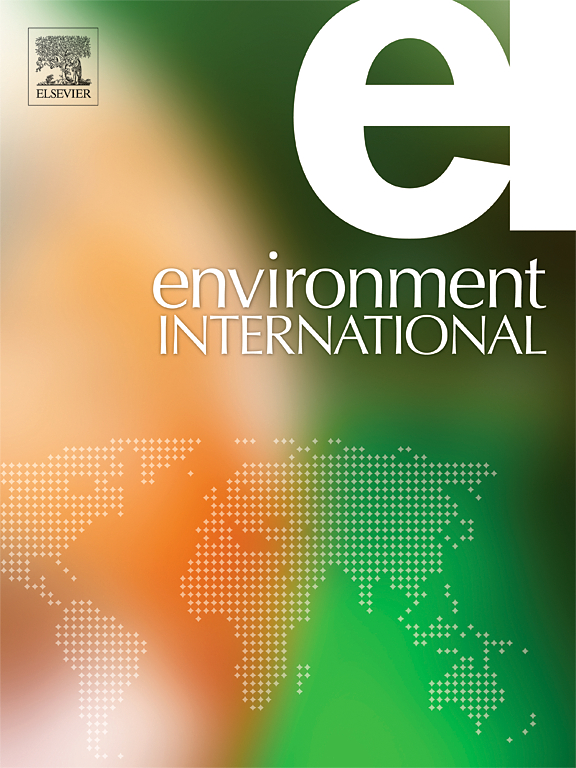Metal bioaccessibility in size-resolved atmospheric particles: Source and aging impacts
IF 10.3
1区 环境科学与生态学
Q1 ENVIRONMENTAL SCIENCES
引用次数: 0
Abstract
Metal bioaccessibility is critical for health effects. The influence of sources and aging processes on bioaccessibility of metals in size-resolved atmospheric particulate matter (PM) remains unclear. Size-resolved bioaccessibility of metals in source-emitted and atmospheric PM was measured in this study. The bioaccessibility of most metals varied greatly with sources, while it remained relatively stable across different sizes for each source. In atmospheric PM, Cu, Mn, Cr, and V showed high bioaccessibility at fine size but low at coarse size especially in floating dust season, indicating effects of combustion sources at fine size and dust sources at coarse size. Atmospheric As and Pb bioaccessibility showed slight size variability and were lower during heating season, linking with enhanced coal combustion with relatively low bioaccessibility. An advanced method was developed to quantify source-specific risk based on size-resolved bioaccessibility. Percentage contributions to cancer risk (CR) of PM10 were the highest for industrial source (IS, 38 %), followed by aged aerosol (AA, 22 %), and coal combustion (CC, 18 %). Contribution of IS was high at sizes < 0.43 µm; and that of CC was high at sizes < 0.43 µm and 1.1–4.7 µm. Additionally, explainable machine learning revealed that atmospheric processes enhanced the Mn bioaccessibility, likely due to highly soluble MnSO4 formed through acid-processing; and increased the Cr bioaccessibility, probably due to increased fractions of hexavalent Cr originating from oxidation processes.


金属的生物可及性对健康影响至关重要。目前还不清楚来源和老化过程对粒径分辨大气颗粒物(PM)中金属的生物可及性的影响。本研究测量了源排放和大气颗粒物中金属的粒度分辨生物可及性。大多数金属的生物可得性随来源的不同而有很大差异,而在每个来源的不同粒度中则保持相对稳定。在大气可吸入颗粒物中,铜、锰、铬和钒在细粒度时生物可及性高,而在粗粒度时生物可及性低,特别是在浮尘季节,这表明在细粒度时受燃烧源的影响,而在粗粒度时受粉尘源的影响。大气中砷和铅的生物可及性显示出轻微的粒度变化,并且在采暖季节较低,这与煤炭燃烧增强而生物可及性相对较低有关。根据粒度分辨生物可及性,开发了一种先进的方法来量化特定来源的风险。工业源(IS,38%)对 PM10 致癌风险(CR)的贡献百分比最高,其次是老化气溶胶(AA,22%)和燃煤(CC,18%)。IS 的贡献率在 0.43 微米和 1.1-4.7 微米时较高,CC 的贡献率在 0.43 微米和 1.1-4.7 微米时较高。此外,可解释的机器学习显示,大气过程提高了锰的生物可得性,这可能是由于酸处理过程中形成了高溶解性的 MnSO4;同时提高了铬的生物可得性,这可能是由于氧化过程中六价铬的含量增加。
本文章由计算机程序翻译,如有差异,请以英文原文为准。
求助全文
约1分钟内获得全文
求助全文
来源期刊

Environment International
环境科学-环境科学
CiteScore
21.90
自引率
3.40%
发文量
734
审稿时长
2.8 months
期刊介绍:
Environmental Health publishes manuscripts focusing on critical aspects of environmental and occupational medicine, including studies in toxicology and epidemiology, to illuminate the human health implications of exposure to environmental hazards. The journal adopts an open-access model and practices open peer review.
It caters to scientists and practitioners across all environmental science domains, directly or indirectly impacting human health and well-being. With a commitment to enhancing the prevention of environmentally-related health risks, Environmental Health serves as a public health journal for the community and scientists engaged in matters of public health significance concerning the environment.
 求助内容:
求助内容: 应助结果提醒方式:
应助结果提醒方式:


